The French submarine Surcouf, launched in 1929, was 361 feet long, and at 3,304 tons was, at that time, the world's largest pre WW2 submarine. Two Sulze diesel engines and two electric motors were used for her propulsion, she could cover 10,000 miles at 10 knots, submerged speed was 8.5 knots, but on the surface she was capable of reaching 18 knots.
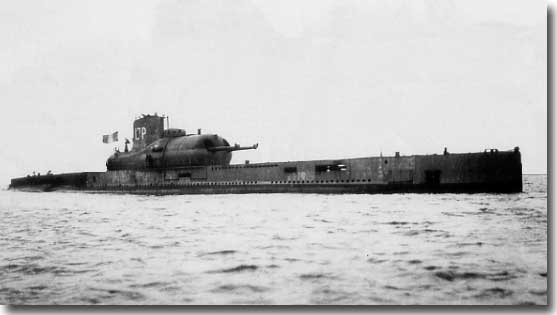
Surcouf, her 8 inch gun turret in evidence
This huge submarine carried twin 8 inch guns in a single turret, quite a formidible armament for a submarine, and in a hangar aft of her conning tower was an observation aircraft, a Marcel Berson-411, capable of a speed of 100 knots with a range of 400 kilometres. A cargo of torpedoes, 14 by 500mm, and another 8 by 400mm added to her fighting abilities. A 16 foot motor boat was also on board.

Surcouf's Seaplane
Refitting at Brest.
When the German Army flooded into France in 1940, Surcouf was in Brest, refitting, she quickly escaped across the Channel to England, on only one available motor. Not all French Naval vessels surrendered to the British, and Surcouf had to be forcibly taken over by the Royal Navy, in the shirmish, two British Officers and a French sailor died. A British Dockyard refitted her, and she was handed over to the Free French Navy in Britain in August 1940.
She sailed west across the Atlantic, and in December of that year, this large submarine along with two French Frigates captured for the Allies the French Islands of St Pierre and and Miquelon, sitting off Newfoundland in the North Atlantic.

Stamp to mark the capture of the island of St Pierre,
it took but 15 minutes to subdue in December 1940.
Surcouf to sail for the Pacific in January 1942.
It is believed that the French intended sailing Surcouf for the Pacific in January of 1942, she went into New London to load fuel/torpedoes etc. and sailed.
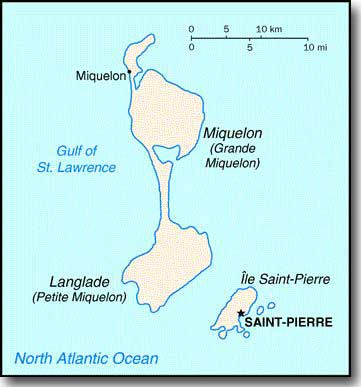
St Pierre and Miquelon, Islands in Atlantic.
Captured by Surcouf and two French Frigates in December 1941.
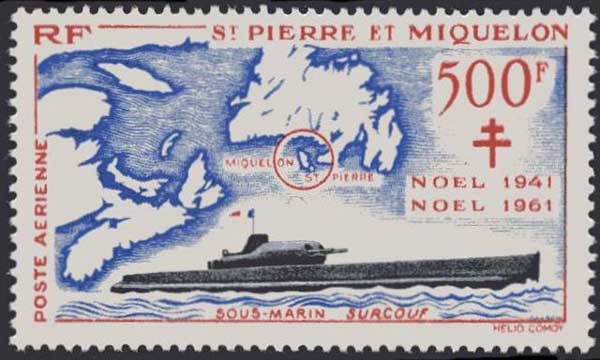
Air Mail stamp to mark the capture of the islands of St Pierre and Migulon
Something odd about the movements of Surcouf.
US tankers were being sunk off the North East coast of the United States, and Surcouf had been caught fueling a German U-Boat. Some think that after sailing in January, the Surcouf was in the vicinity of the Panama Canal, where she was run down accidentally by the US freighter Thompson Lykes, but this ship had a tonnage not a great deal more than the French Submarine. When viewed in dry dock after the freighter had hit some object, the damage to her bows looked somewhat minor, much less than would be expected if she had collided with Surcouf.
But at the time, a popular theory as to the French submarine's demise was: When caught refueling a German U-Boat she was sunk by US Submarines or a Navy Blimp.
We may never know the fate of this huge pre WW2 French Submarine.
But the mystery about the disappearance of Surcouf, may never be solved, the truth about how she came to be sunk will have to wait until the wreck is discovered some time in the future. Of course, that may never come to pass, and in the meantime, naval historians, and others interested in this mystery can but speculate, and individuals will differ on how she came to die.
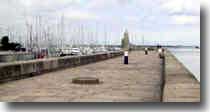
At the end of this pier at Cherbourg is the Monument to the loss of 130 sailors
in the huge French submarine Surcouf in February 1942.

Plaque on Memorial at Cherbourg, listing the names of sailors who died in Surcouf when she disappeared on the 18th. of February 1942.
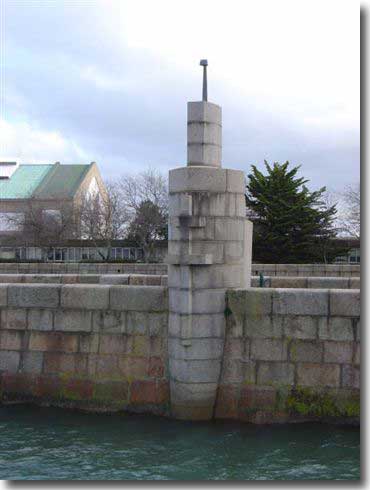
The Surcouf Memorial on the end of the small jetty at Cherbourg.
The plaque carrying the 130 names of those who died is located on the
other side of this Memorial. General de Gaulle unveiled the Memorial in 1951.
From an Ahoy Reader:
A friend of mine was stationed at the U.S. Naval Submarine Base in New London Connecticut the same time that the Surcouf was there. A U-boat was sunk off the New England coast by Destroyers and some of the flotsom that came to the surface was loaves of bread still in their wrappers from a bakery in New London. The Navy figured that the Surcouf had to be supplying the u-boats with food. Also she would go to sea with a full load of torpedoes for training purposes and come back having expended a number of them. The Navy also figured she was sinking our ships as well as supplying the u-boats. According to him one of our submarines followed her out to sea and when they found her setting up to torpedo one of our ships, the U.S. Submarine torpedoed her. End of Story. Naturally nothing could be said about this because it would have upset the Free French, so everything was hushed up. I don't know what U.S. Sub it was that sank her.
Dick Miller
9 November 2008 from eBay
FREE FRENCH SUB SURCOUF & ST EXUPERY OF THE SEA BONUS
"Offered is the well illustrated, 43 page monograph, and expansion of Debunking Foul Rumors about the Free French Submarine SURCOUF the cover of which appears above.
"The Seller made this presentation before an audience at the Anglo-Panamanian Society, British Embassy, Republic of Panama, on August 30, 1988. There is immense interst about SURCOUF in Panamanian circles as she was sunk on the night of Februray 18, 1942 approximately 80 nautical miles NNE of the Panama Canal Zone..."
Read more:
French Leviathan By William Sariego October 2006
Surcouf is one of the most fascinating ships of the Second World War. When launched she was the largest submarine in the world,








